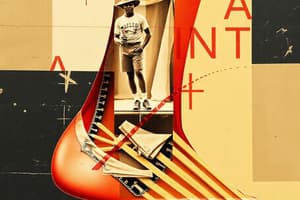Podcast
Questions and Answers
What should be considered if symptoms persist or worsen after an ankle injury?
What should be considered if symptoms persist or worsen after an ankle injury?
- Immediate imaging studies
- Referral to a surgeon (correct)
- Referral to a physiotherapist
- Increased pain medication
Which of the following assessments are important for preventing recurrent ankle sprains?
Which of the following assessments are important for preventing recurrent ankle sprains?
- Restoring ankle dorsiflexion and plantarflexion (correct)
- Evaluating the patient's balance
- Performing ultrasound imaging
- Assessing the strength of the peroneal muscles
What technique may be used if the interosseous membrane shows restricted motion?
What technique may be used if the interosseous membrane shows restricted motion?
- Electrotherapy
- Cold therapy application
- Joint mobilization
- Myofascial release (correct)
Which advanced technique aims to optimize ankle stability and function?
Which advanced technique aims to optimize ankle stability and function?
What is a key focus during outcome assessment after ankle treatment?
What is a key focus during outcome assessment after ankle treatment?
Which of the following criteria are part of the Ottawa ankle rules for determining the need for x-rays? (Select all that apply)
Which of the following criteria are part of the Ottawa ankle rules for determining the need for x-rays? (Select all that apply)
What is the primary ligament affected in most ankle sprains?
What is the primary ligament affected in most ankle sprains?
Which of the following is NOT a common clinical presentation of an ankle sprain?
Which of the following is NOT a common clinical presentation of an ankle sprain?
What does the Ottawa Ankle Rules help determine?
What does the Ottawa Ankle Rules help determine?
When assessing for fractures in an ankle injury, what tenderness indicates a low risk of fracture?
When assessing for fractures in an ankle injury, what tenderness indicates a low risk of fracture?
Which of the following is part of the symptomatic management for an ankle sprain?
Which of the following is part of the symptomatic management for an ankle sprain?
What is one of the goals of the functional rehabilitation for an ankle sprain?
What is one of the goals of the functional rehabilitation for an ankle sprain?
Which method is recommended for early controlled movement in ankle sprain recovery?
Which method is recommended for early controlled movement in ankle sprain recovery?
What role do NSAIDs play in managing an ankle sprain?
What role do NSAIDs play in managing an ankle sprain?
Flashcards are hidden until you start studying
Study Notes
Overview of Ankle Sprains
- Ankle sprains frequently result from injury to the lateral ligament, primarily the anterior talofibular ligament (ATFL), due to inversion and supination.
- Symptoms include localized tenderness, bruising, swelling, decreased range of motion, warmth, and potentially visible deformity.
Assessment in the Emergency Room
- Conduct a thorough physical examination that includes assessing tenderness, bruising patterns, swelling extent, and any pitting edema.
- Utilize the Ottawa Ankle Rules to determine the necessity of X-rays based on tenderness at specific anatomical points and the patient's ability to bear weight.
Imaging Considerations
- X-rays are crucial for ruling out fractures involving the ankle mortise, malleolus, talus, or fibula.
- A clinical assessment indicating tenderness 6 cm up the fibula without pain suggests a low risk for fractures, while the ability to bear weight post-injury further informs fracture likelihood.
Treatment Approaches
- Symptomatic management consists of rest, ice application (20 minutes on, 40 minutes off), compression, and elevation to decrease swelling.
- Immobilization with air or gel-filled casts can stabilize the ankle during recovery.
Osteopathic Manipulative Medicine (OMM)
- Early, controlled range of motion exercises are encouraged to prevent stiffness and aid healing.
- Myofascial release techniques are beneficial for enhancing ankle motion, particularly focusing on interosseous membranes.
- Fibular head manipulation can help restore stability and prevent further injury.
Rehabilitation and Follow-up
- Functional rehabilitation involves exercises to restore full range of motion, promote lymphatic drainage, and enhance balance and strength.
- Nonsteroidal anti-inflammatory drugs (NSAIDs) are recommended to manage inflammation and pain.
- Consider referral to a surgeon for persistent or worsening symptoms that may imply a significant ligamentous tear requiring surgery.
Osteopathic Considerations
- A thorough biomechanical assessment is critical to ensure restored dorsiflexion and plantarflexion, reducing the risk of recurrent sprains.
- Assess the interosseous membrane for strain and apply myofascial release if restricted motion is ongoing.
Advanced Techniques
- Balanced ligamentous tension involves adjusting tension in the fibular head and interosseous membrane to enhance ankle stability and function.
- Gentle fibular head manipulation can realign the fibular head if displaced, supporting the restoration of normal biomechanics.
Conclusion
- Conduct regular evaluations of range of motion, pain levels, and overall functional ability post-treatment.
- Patient education is vital, focusing on rehabilitation exercises, appropriate footwear, and precautions to prevent future sprains.
Studying That Suits You
Use AI to generate personalized quizzes and flashcards to suit your learning preferences.




